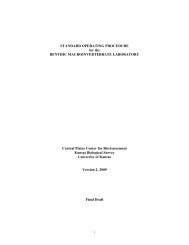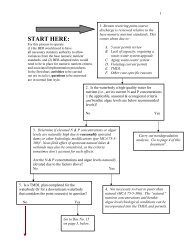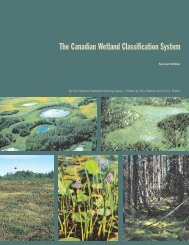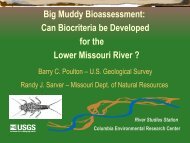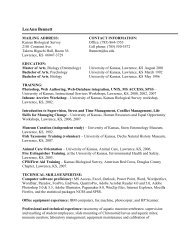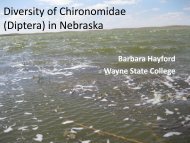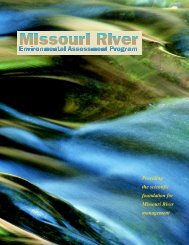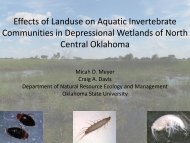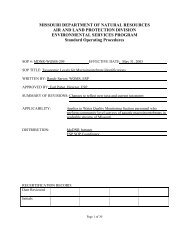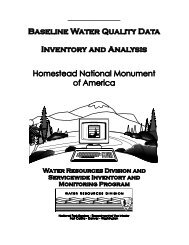Koontz, J., D.G. Huggins, C.C. Freeman, D.S. Baker - Central Plains ...
Koontz, J., D.G. Huggins, C.C. Freeman, D.S. Baker - Central Plains ...
Koontz, J., D.G. Huggins, C.C. Freeman, D.S. Baker - Central Plains ...
You also want an ePaper? Increase the reach of your titles
YUMPU automatically turns print PDFs into web optimized ePapers that Google loves.
measurement. There are sites within our sample population that are considered lacustrine, but<br />
due to drought conditions in 2005, at least one of these sites was completely dry apparently due<br />
to water use on surrounding agricultural areas. Upon revisit during Phase II, this site had a<br />
maximum depth of 1.15 m and appeared to have lacustrine qualities, including an extensive<br />
aquatic bed habitat and a fish population. Given that rainfall, river flooding, and evaporative<br />
processes may significantly affect floodplain wetland water depth during any year or season, the<br />
use of water depth to define the difference between lacustrine and palustrine should be used with<br />
caution. In the EPA‟s National Lake Survey, lake sites that were less than 1 m deep were<br />
excluded. Perhaps 1 meter is a better threshold for helping distinguish between deepwater<br />
habitats (e.g. lacustrine) and palustrine wetlands. It should also be noted that the NWI dataset<br />
for wetland bodies assumes that wetlands with large surfaces areas are also deeper and thus are<br />
assigned to the lacustrine class. In our study, many discrepancies were found between the NWI<br />
classification and existing water body conditions. Because true lake sites did exist, and<br />
relationships were found between and among lacustrine, palustrine, and riverine wetlands, this<br />
major classification scheme was retained along with the dominant vegetation type and the<br />
lacustrine zone of the surveyed wetland.<br />
Kruskal-Wallace non-parametric tests by CPCB type indicated that emergent macrophyte bed<br />
types (n = 25) have significantly (p = 0.001) shallower mean depths than aquatic bed types (n =<br />
9), unconsolidated bed types (n = 15), and MIX types (n = 7), based on normal Z value<br />
differences. However, more discriminate Bonneferonni Z value tests only indicated that AB and<br />
EM differed significantly. Differences in maximum depth were found to be significant (p =<br />
0.001) among types, though normal Z tests only showed that AB and EM were statistically<br />
different. When populations were separated by major classes (lacustrine and palustrine), no<br />
significant differences were found among the mean and maximum depth means. Mean and<br />
maximum depth positively correlated with mean Secchi depth, TN:TP, and each other, and were<br />
found to be negatively correlated with mean turbidity, total phosphorus, organic phosphorus,<br />
TOC, and DOC concentrations. Robust linear regression analysis showed that a significant<br />
positive relationship existed between mean depth and TN:TP ratio (p = 0.001, R 2 = 0.183).<br />
Maximum depth and TN:TP relationship was even stronger (p < 0.000, R 2 = 0.28). Maximum<br />
depth and mean Secchi depth relationship was significant and positive (p < 0.000, R 2 = 0.28),<br />
while mean depth and mean Secchi depth was also significant (p < 0.000, R 2 = 0.25). Mean<br />
turbidity was significantly correlated (negative) with mean depth but explained very little of the<br />
variance between these factors (p = 0.029, R 2 = 0.069). Maximum depth was also significantly<br />
correlated with mean turbidity (p = 0.014, R 2 = 0.093). Total phosphorus was negatively related<br />
to maximum depth (p = 0.093, R 2 = 0.25) and mean depth (p



